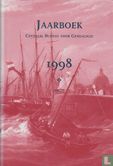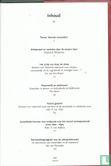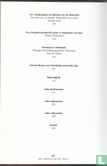Genealogy, sibbekunde or family tree research is a discipline of history that deals with ancestral research or the descent of the family name. Obviously, practicing genealogy is a very infectious activity, given the growing popularity of this leisure activity. It is not to be confused with family history.
Origin of surnames:
Surnames can be derived in different ways: the name can relate to the first name of one of the parents, parents-in-law or grandparents; this is called a patronymic. An example of this is Willem Janszoon, abbreviated to Willem Jans. The surname can also be related to the geographical location where one comes from (toponym), for example Jan van Boxmeer (from the place Boxmeer), but also Piet van de Ven (from a peat area) or Van de (r) Wijst (from grounds). A special form of toponyms occurs in Flanders, Brabant and the east of the Netherlands: farm names. People named themselves after the farm or inn where they lived, such as Leferink or Groot-Kromkamp.
Many surnames have been corrupted over time due to clerical and clerical errors. Verbruggen next to Vanbrugge, Van Brugge or Dupont occur, so that finding out such family names can be quite a job. On the other hand, the phenomenon of naming used to occur frequently, so that a certain first name or a small variation on it was regularly applied to the descendants, which in turn offers some guidance.
Under the regime of Napoleon, with the introduction of the registry office in 1811, it became mandatory to use a surname. In the Duchy of Brabant and in Flanders, family names had already stabilized almost everywhere in 1500, so that this did not really pose a problem. In certain regions of the Netherlands, however, it can cause problems for a genealogical researcher, because a family suddenly changed their surname. The adoption of a surname was recorded in the so-called registers of name adoption, which are part of the population register.
Research:
Main shapes:
Descendants, graphically represented as parentage Most genealogists choose a certain type of research. There are four main shapes:
Tribal series: all ancestors in the male line, from present to past;
Pedigree chart: all ancestors in male and female lines, from present to past;
Genealogy: all descendants in male line;
Parental: all offspring in both male and female line.
The overview above shows that the word genealogy also has a limited meaning: that of an overview of all descendants in the male line.
Genealogical Resources:
Historical sources are important for genealogical research. These sources can be, for example:
Personal data:
Personal cards and personal lists
Baptism, marriage and burial registers (church records, "DTB" for short)
The Civil Registry (birth, marriage and death registers)
The Population Register
Memories of Succession
Notarial archives
Alderman Archives
Prayer cards
Incidentally, it can be concluded that the collected data becomes more interesting as it is supplemented with personal documentation such as family photos and driving licenses, which provides more dimension.
DNA research:
Processing genealogical data
Once genealogical data has been collected by asking family members questions, searching for preserved documents and / or photos and the stories behind them, visiting archives, whether physical or on the Internet, these data should be made clear by means of a particular system of ordering. This makes the relationship between the different names visible and at the same time it becomes clear where there are any gaps that can be filled in further. This can of course be done by using pen and paper, but the use of a computer has also made its appearance in the field of genealogy. Incidentally, the computer is ideally suited for processing large numbers of data.
To simplify the exchange of data created with genealogy software, a standard file format has been developed, called gedcom (file extension: .ged). There is a wide choice of genealogical software, of course in English but certainly also in Dutch, both paid and free, from very simple to very complex. Aldfaer is a free program in Dutch. Another widely used program is Pro-Gen.
To determine or confirm the possible relationship between persons, the researcher can currently enlist the help of DNA research. The DNA of persons from the same ancestors will be more similar than the DNA of unrelated persons. The mitochondrial DNA is only passed on through the mother and is thus a source to investigate maternal lineage. The Y chromosome is DNA that is only passed on through a paternal route.
Publishing genealogical data:
After compiling the data, there is often a desire to publish the findings, either in print or on the Internet. There are printers that specialize in small editions, where family books can be printed. But the most common form of publication since the advance of computers and the Internet is of course the homepage / website, both from an organization or archive as well as the personal home pages. This again led to the need to create overview sites, portals and special search engines exclusively for making the many genealogical data accessible.
When publishing genealogical research, the researcher must be aware of informal legal aspects, such as the public nature of data, and the safeguarding of the privacy of persons who are still alive.
Genealogical societies in the Netherlands:
Since the last quarter of the nineteenth century, many different genealogical-heraldic associations have been established in the Netherlands. The main national associations from both the past and the present are:
The Central Bureau for Genealogy (1945-) publishes a quarterly magazine "Genealogy" in addition to the Yearbook;
The "Royal Netherlands Society for Sex and Heraldry" (1883-) with the organ "De Nederlandsche Leeuw";
The "Nederlandsch Verbond voor Sibbekunde" (1941-1944). She published the magazine "Sibbe";
The "Dutch Genealogical Society" (1945-). She publishes the magazine "Gens Nostra";
The Association "De Nederlandsche Heraut" (1881-1897) with an eponymous magazine during those years.
The computer and genealogy association "HCC! Genealogie" (1986-). She publishes the magazine Gens Humana and a member CD with genealogical data from and by the members.
In addition, the following national periodicals were published:
The Algemeen Nederlandsch Familieblad (1883-1895 and 1900-1905).
The Navorscher (1851-1960).
The Herald of Arms (1897-1920).
Genealogy as a philosophical method:
In a metaphorical sense, one speaks of genealogy as a historical method, which focuses on current views (for example with regard to morality, psychiatry, sexual orientation, personal identity) and shows and analyzes the historical origins of these views. Friedrich Nietzsche and Michel Foucault are well-known philosophers who conducted genealogical research.
See also Nietzsche's genealogy. For Foucault's influential interpretation of Nietzsche, see: Nietzsche, genealogy, historiography.
This text has been translated automatically from Dutch
Click here for the original text
Genealogie, sibbekunde of stamboomonderzoek is een discipline van de geschiedkunde die zich bezighoudt met voorouderlijk onderzoek dan wel de afstamming van de familienaam. Het beoefenen van genealogie is duidelijk een zeer aanstekelijke bezigheid, gezien de groeiende populariteit van deze vrijetijdsbesteding. Het dient niet te worden verward met gezinsgeschiedenis.
Herkomst van achternamen:
Achternamen kunnen op verschillende manieren tot stand zijn gekomen: de naam kan betrekking hebben op de voornaam van een van de ouders, schoonouders of grootouders; dit heet een patroniem. Een voorbeeld hiervan is Willem Janszoon, afgekort tot Willem Jans. De achternaam kan ook verband houden met de aardrijkskundige plek waar men vandaan komt (toponiem), bijvoorbeeld Jan van Boxmeer (van de plaats Boxmeer), maar ook Piet van de Ven (uit een veengebied) of Van de(r) Wijst (afkomstig van wijstgronden). In Vlaanderen, Brabant en Oost-Nederland komt een speciale vorm van toponiemen voor: boerderijnamen. Mensen vernoemden zich naar de boerderij of herberg waarin ze woonden, zoals Leferink of Groot-Kromkamp.
Door verschrijvingen van ambtenaren en geestelijken zijn vele achternamen in de loop van de tijd verbasterd. Verbruggen naast Vanbrugge, Van Brugge of Dupont komen voor, zodat het uitzoeken van dergelijke familienamen een hele klus kan zijn. Daarentegen kwam het fenomeen vernoemen vroeger veelvuldig voor, zodat een bepaalde voornaam of een kleine variatie daarop regelmatig weer bij de nakomelingen werd toegepast, wat weer enigszins houvast biedt.
Onder het regime van Napoleon werd het met de invoering van de burgerlijke stand in 1811 verplicht een achternaam te voeren. In het hertogdom Brabant en in Vlaanderen waren de familienamen in 1500 al bijna overal gestabiliseerd, zodat dit niet echt een probleem opleverde. In bepaalde streken van Nederland kan het voor een genealogisch onderzoeker echter problemen opleveren, omdat een familie ineens van achternaam veranderde. Het aannemen van een achternaam werd vastgelegd in de zogenaamde registers van naamsaanneming, die onderdeel van het bevolkingsregister zijn.
Onderzoek:
Hoofdvormen:
Nakomelingen, grafisch weergegeven als parenteelDe meeste genealogen kiezen voor een bepaald soort onderzoek. Er zijn vier hoofdvormen te onderscheiden:
Stamreeks: alle voorouders in mannelijke lijn, van heden naar verleden;
Kwartierstaat: alle voorouders in mannelijke en vrouwelijke lijn, van heden naar verleden;
Genealogie: alle nakomelingen in mannelijke lijn;
Parenteel: alle nakomelingen in zowel mannelijke als vrouwelijke lijn.
Bovenstaand overzicht laat zien dat van het woord genealogie ook een beperkte betekenis is: namelijk die van een overzicht van alle nakomelingen in mannelijke lijn.
Genealogische bronnen:
Om genealogisch onderzoek te kunnen doen zijn historische bronnen van belang. Deze bronnen kunnen bijvoorbeeld zijn:
Persoonsgegevens:
Persoonskaarten en persoonslijsten
Doop-, trouw- en begraafregisters (kerkelijke administratie, kortweg "DTB" genoemd)
De Burgerlijke Stand (geboorte-, huwelijk- en overlijdensregisters)
Het Bevolkingsregister
Memories van successie
Notariële archieven
Schepenbank-archieven
Bidprentjes
Overigens kan geconstateerd worden dat de verzamelde gegevens interessanter worden naarmate deze aangevuld worden met persoonlijke documentatie zoals familiefoto's en rijbewijzen, hetgeen voor meer dimensie zorgt.
DNA-onderzoek:
Verwerken van genealogische gegevens
Zodra men genealogische gegevens heeft verzameld door het stellen van vragen aan familieleden, het zoeken naar bewaard gebleven documenten en/of foto's en de verhalen daarachter, het bezoeken van archieven, hetzij fysiek of op internet, moeten deze gegevens overzichtelijk worden gemaakt door middel van een bepaald systeem van ordenen. Hierdoor wordt de samenhang tussen de verschillende namen zichtbaar en wordt gelijkertijd duidelijk waar zich eventueel lacunes bevinden die nader ingevuld kunnen worden. Dit kan natuurlijk door het gebruik van pen en papier, maar het gebruik van een computer heeft ook op genealogisch gebied zijn intrede gedaan. Overigens leent de computer zich bij uitstek voor verwerking van grote aantallen gegevens.
Om het uitwisselen van gegevens welke zijn gemaakt met genealogische software te vereenvoudigen, is een standaard bestandsformaat ontwikkeld, gedcom geheten (bestandsextensie: .ged). Er is een ruime keuze aan genealogische software, uiteraard in het Engels maar zeker ook in het Nederlands, zowel betaald als gratis, van heel eenvoudig tot zeer complex. Aldfaer is een gratis programma in het Nederlands. Een ander veel gebruikt programma is Pro-Gen.
Om de mogelijke relatie tussen personen te bepalen of te bevestigen kan de onderzoeker momenteel de hulp inschakelen van DNA-onderzoek. Het DNA van personen afkomstig van dezelfde voorouders zal meer onderlinge gelijkenis vertonen dan het DNA van niet verwante personen. Het mitochondriaal DNA wordt enkel doorgegeven via de moeder en is dus een bron om de afkomst via maternale weg te onderzoeken. Het Y-chromosoom is DNA dat enkel via paternale weg wordt doorgegeven.
Publiceren van genealogische gegevens:
Na het samenstellen van de gegevens volgt vaak de wens de bevindingen te publiceren, hetzij in druk hetzij op internet. Er zijn drukkerijen te vinden die zich specialiseren in kleine uitgaven, waar men familieboeken kan laten drukken. Maar de meest voorkomende vorm van publicatie sinds de opmars van computers en internet is natuurlijk de homepage / website, zowel vanuit een organisatie of archief alsook de persoonlijke homepages. Hieruit vloeide weer de noodzaak tot het maken van overzichtssites, portals en speciale zoekmachines uitsluitend voor het toegankelijk maken van de vele genealogische gegevens.
Bij het publiceren van genealogisch onderzoek moet de onderzoeker zich bewust zijn van infoamarief rechtelijke aspecten, zoals de openbaarheid van gegevens, en de waarborg van de privacy van nog in leven zijnde personen.
Genealogische verenigingen in Nederland:
Sinds het laatste kwart van de negentiende eeuw zijn er in Nederland vele verschillende genealogisch-heraldische verenigingen opgericht. De voornaamste landelijke verenigingen uit zowel het heden als verleden zijn:
Het Centraal Bureau voor Genealogie (1945-), geeft naast het Jaarboek ieder kwartaal een tijdschrift "Genealogie" uit;
Het "Koninklijk Nederlandsch Genootschap voor Geslacht- en Wapenkunde" (1883-) met als orgaan "De Nederlandsche Leeuw";
Het "Nederlandsch Verbond voor Sibbekunde" (1941-1944). Zij gaf het tijdschrift "Sibbe" uit;
De "Nederlandse Genealogische Vereniging" (1945-). Zij geeft het tijdschrift "Gens Nostra" uit;
De Vereniging "De Nederlandsche Heraut" (1881-1897) met een gelijknamig tijdschrift gedurende die jaren.
De computer- en genealogievereniging "HCC!genealogie" (1986-). Zij geeft het tijdschrift Gens Humana en een leden-CD met genealogische gegevens van en door de leden uit.
Daarnaast verschenen de volgende landelijke periodieken:
Het Algemeen Nederlandsch Familieblad (1883-1895 en 1900-1905).
De Navorscher (1851-1960).
De Wapenheraut (1897-1920).
Genealogie als filosofische methode:
In overdrachtelijke zin spreekt men van genealogie als een historische methode, die zich op huidige opvattingen richt (bijvoorbeeld wat betreft moraal, psychiatrie, seksuele oriëntatie, persoonlijke identiteit) en het historische ontstaan van deze opvattingen toont en analyseert. Friedrich Nietzsche en Michel Foucault zijn bekende filosofen, die genealogisch onderzoek verrichtten.
Zie ook Nietzsches genealogie. Voor Foucaults invloedrijke interpretatie van Nietzsche, zie: Nietzsche, de genealogie, de geschiedschrijving.











